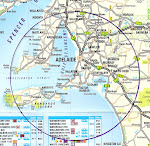Extracting Honey with Robert Beer
Above is an example of the beautiful work of bees when there is no foundation for them to work on
The hard work of bees
Home extraction set up
The frame just out of the hive box and chock a block full of honey. Robert removes the wax caps off the comb to allow honey to flow out
Into the spinner
The honey spins out
We spin out too
Honey at the bottom of the spinner
honey pouring out of the spinner
The wax caps with honey draining out into bottom tray
We had a great day watching Robert at work, and having a go ourselves. We extracted approximately 15 kilos of honey from our hive! I was impressed with the simplicity of the whole process but a bit put off by the presence of so many dead bees in our honey.
The Bee group group spent a few hours in Elizabeth's kitchen decanting the dark honey into jars, and shared it out between ourselves.
A few days later, I found these two bees in a jar of Honey Lady honey, so I felt better about our harvest as it is obviously unavoidable to get some bees in the honey?
Carob Processing
Apparently Carob Contains 40 to 50% natural sugar by dry weight, and carob pods were the most widely used source of sugar for centuries before sugarcane and sugar beets became popular.
To make home-made carob syrup: remove the seeds from the pods, soak 300g of broken up carob pod in 750ml water for 12hr, process in a blender in small portions, continue soaking for 30-35hrs. Filter though a linen towel and pour into bottles. Place in the fridge for a day to settle. Filter the solution through cotton wool in a funnel, measuring the volume at intervals until it represents 15% of the original solution. Care needs to be taken to prevent the syrup from turning into solid caramel. The syrup makes a delicious topping for ice cream, in milk shakes or in savoury dishes as a marinade for meat. To make carob powder: Pressure-cook the pods with water for 20min. This softens the pods and aids seed removal. Discard seeds and cut pod into small pieces then dry. When dry place in a blender and grind into a powder as required. To make sweet carob cubes: 2 cups sugar, 1/4 cup butter, 3/4 cup ground carob, 2/3 cup milk, 1 tsp vanilla essence, pinch of salt. Place all ingredients except vanilla in a heavy saucepan and bring to the boil stirring constantly. Simmer until liquid reaches the soft boil stage. Remove from heat and add vanilla. Beat mixture until thick. Pour into a buttered tray or dish and allow it to cool. Cut into cubes.
Neville Passmore [20/12/2002]

Carob from our orchard
deseeding the carob pods is quite a hard job as the pods have sticky honey like substance inside and the pods are tuff to separate. soak pods in water
1/ 2 of pods I dried in dehydrator and ground in processor. Above this course ground carob is too big to be used as a powder, but I think I can use it in a granola or museli mix, it tastes quite sweet. 

some came out finer than others, this fine powder was around the base of the blade, and I will use it as a carob powder substitute for cocoa.
blended with water
sieved
liquid is cooked and bottled to be used as a sauce
I forgot to soak the carob pods for 30-35 hours, and did not extract the seeds using a pressure cooker (they scare me) That might be the reason that the syrup is a little bitter?
leftovers are made into balls (thanks to Lynda's ingenious suggestion)
mixed with almonds and honey
salt and vanilla essence
rolled in fine carob powder
refridgerated and ready to eat yum, they were a little chewy, and definitely needed sweetening with honey, they also were a bit moist, so I tried a batch with butter, hoping they would solidify more in the fridge. The buttery ones were the best, this needs more research and development, and more tasters. I took them with us on our easter camping trip and they were eaten with some reservation, but also nods of encouragement. (probably being polite) Unfortunately two containers got water logged from the melted ice in the bottom of the esky, so I sacrificed them to the wild animals of Arkaroola - such a waste.
Carob Ball presents for our neighbours ( an easter egg substitute) Alas no easter eggs for us this year!
But we did have some lovely Carob Honey Brownies!
Honey Carob Brownies
1 cup whole wheat flour
1 tsp baking powder
1/4 tsp salt
1/2 cup butter
1/2 cup carob powder
1 cup raw honey
2 eggs
1/2 cup chopped nuts
1 tsp vanilla
sift dry ingredients. Melt butter, add carob & honey & blend well, removing from heat. Beat eggs & gradually add to carob mix. Add dry ingredients and mix well. Blend in vanilla & nuts. Pour into oiled 8 inch square pan & bake at 250C for 45 mins, or until done.
These were definitely a winner - we did not even share any of these with our convoy friends - sorry Tom & Hilde, Nathan & Levi, they were too delicious!




























No comments:
Post a Comment